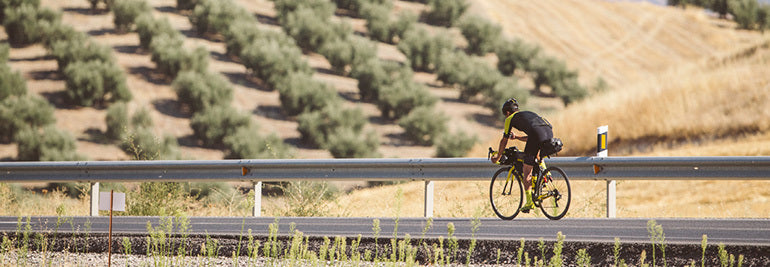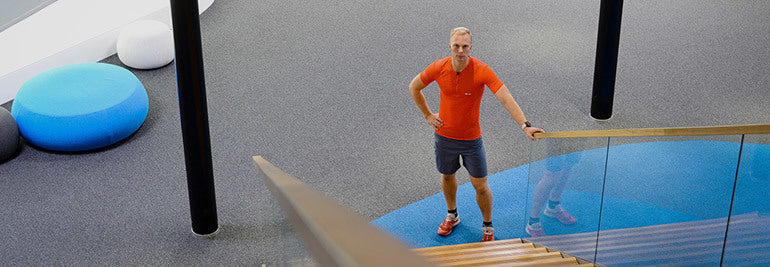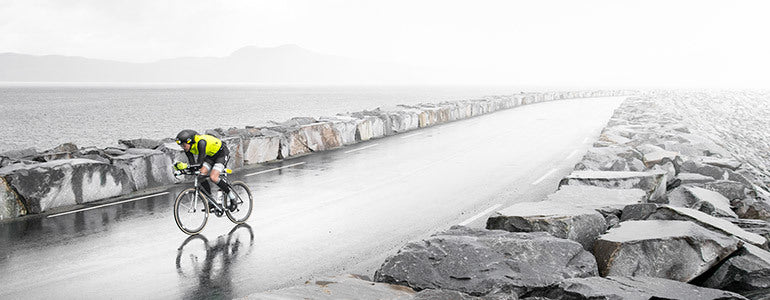

Suunto Blog

Fuelling the engine: talking nutrition with Melissa Hauschildt
Buying good quality and diverse produce and preparing nutritious meals is as important for our training as time spent running, cycling, swimming or at the gym. Yet, for many of us – especially for those of us with full time jobs and families – it’s tempting to cut corners when it comes to diet. We tell ourselves “next time”, and whip up a fast meal that fills the hole, but doesn’t fuel the engine.
Training is all about consistency and honesty. We shouldn’t try to fool ourselves; when we cut corners we don’t really gain in the long run. Instead, the training lifestyle is all about dedication to our sport, and the truth is, at the heart of that is caring for our bodies.
In this series of posts we explore how Suunto ambassadors and athletes keep their tanks fuelled. In this second instalment, we meet another Australian athlete, Melissa Hauschildt, an Ironman champion who recently set a new world record for fastest time (8:31:04) at the Ironman North American Championships, Texas in April.
The long term outlook
Good nutrition is a major part of Hauschildt’s life. Racing in Ironmans all over the planet, as the 35-year-old does, demands she feeds her engine with only the best fuel. “To be the best athlete I can I need to fuel my body correctly, but it's also important for life after sport,” she says. “I want to stay fit and healthy so I eat a healthy balanced diet.”
Maintaining good diet in busy times
Eating healthy can easily go out the window in busy times – how does Hauschildt maintain it? She prepares ahead of time. “I always have a healthy snack ready to go – nuts are always in abundance in my house, as well as bananas and apples,” she says. “I make almond butter and buckwheat bread at the start of the week so that’s always provides for great quick and easy snacks – almond butter and banana on toast or almond butter on apple.
“I also use Megaburn products. They make the best protein bars, with all natural ingredients, and so delicious! I always have a stack of them in the house. If I know it’ll take a while to make a meal after training, I will have a Megaburn protein shake immediately after so I can then take my time making a nutritious meal and not snack on junk.”
Natural is best
“I try to eat foods in their most natural form. I eat a lot of salad and vegetables, meat, nuts and eggs. I only eat full fat dairy. I make my own healthy treats as well, as my own bread and almond butter. I try to avoid packaged foods and refined sugar. I avoid soy, lentils, anything labeled ‘low fat’ or ‘diet’ and limit grains. I eat a lot of good fats - butter, olive and coconut oil, avocado, nuts, seeds, eggs.”
Easy, go-to meals
“My easy go-to meals tend to be a large salad with some meat. If I don't have any meat in the fridge I always have canned tuna and sardines in the cupboard or eggs. Another quick and easy go to meal for me is an omelette loaded with salad and left over meat or tuna.”
Kangaroo rice bowl
Ingredients:Wild riceKangaroo filletsRocketRed onionSnow peasTomatoShallotsCorianderAvocadoBlue cheeseOlive oilLime
Directions:
1. Cook rice to packet instructions. BBQ kangaroo fillets to medium/rare. Kangaroo gets very tough if overcooked. 2. Pre cut salads.3. Mix some olive oil and lime juice together for dressing. Grate some lime rind.4. Place cooked rice in bowl then arrange cut salads over it. Crumble some blue cheese on top. Sprinkle with lime rind. Pour over dressing.
Lead image: Photo by Ive Erhard on Unsplash.
READ MORE
Fuelling the engine: Talking nutrition with trail runner Lucy Bartholomew

Out of the freezer into the pan: ultracycling man battles a heatwave
Ultra cyclist Omar Di Felice is back in Italy taking a well-earned break before he begins preparations for his annual journey into the icy reaches of the winter Arctic. He is conditioned to the cold, which is why the Transiberica Bike Race in Portugal and Spain gave him a run for his money.
What were the highlights of the race?
Riding for so long unsupported in this bike race without a mandatory route was a new challenge for me. I didn’t know Spain and Portugal, which is why I had to stay attentive to the way ahead instead of focusing on “eat, sleep and drink” as is usual in normal ultracycling races.
What were the toughest moments?
I really love winter and Arctic conditions: unfortunately in Spain I found completely opposite weather conditions! The toughest thing was to ride in such hot conditions (temperature from 30 to 41°C!). The toughest moment, for sure, was when I had to stop after intense heat and an allergic attack while passing through Andalucia region. When I was back on my bike I understood if I could push through that difficult moment I would be able to end the race.
Where were the nicest roads to ride?
The last 300 km was the nicest! Both because the end got closer and closer, and because the Asturias region was one of the best, with easy climbs, green hills and the perfect temperature to ride.
How many kilometers have you already ridden this year?
This year has had plenty of cycling! From my Arctic adventures in Iceland and Canada, to this last extreme challenge competing in ultracycling races all over Europe, I have clocked up 30,000 kilometers and 450.000 m of ascent. I have earned a deserved rest period before the start of my favorite season: the winter.
READ MORE ABOUT OMAR DI FELICE
During a 3,380km ride you don’t know what will hurt the most
Meet the Italian guy who cycles insane distances
What you really need to know about winter cycling adventures

Make everything count: 7 tips for office workers to get moving
At Suunto headquarters in Finland we try to practice what we preach. Which is why we have an in-house personal trainer to motivate us all to stay fit and healthy.
Matias Anthoni, 26, roams the offices, dropping by rooms, calling on us to get up and to join him for short exercise breaks on the spot. Resistance is futile!
Matias sees stairs as an opportunity to stay active.
“My job is to maintain the health and wellbeing of everyone at Suunto,” the former footballer turned trail runner says. “Everyone who works for the company can use me free of charge. I offer group exercise classes, personal sessions, nutritional advice, and random exercise breaks. Everyone understands it’s a great opportunity.”
Matias has a Bachelor in Sports and Health Promotion, and believes there are many opportunities throughout the day for office workers to take care of their bodies and minds. Here are his tips:
1. Everything counts
Remember this phrase and make it your mantra. It cuts through all the excuses about not having time. Sometimes we get stuck in an “all or nothing” mindset; if we can’t, for example, go for an hour long run or a full gym workout, we don’t do anything at all, failing to see the possibilities that are often right in front of our faces, and don’t take much time. Matias says it’s about thinking laterally, and making everything count.
2. Three x three minutes
Take three, three-minute exercise breaks a day. Set a timer on your phone, and do it. Invite your colleagues to join you. To get you started, here’s a short video of Matias demonstrating a few simple movements – try them! “Getting the blood flowing is good for the brain,” Matias says.
3. Go out of your way
When you need to go to the bathroom or get water or coffee, rather than going to the closest option, get in some extra movement and take an extra flight of stairs to do what you need on a floor above or below. Go out of your way for the sake of a little extra movement. It all counts.
4. Have walking meetings
When you have a simple catch up meeting that doesn’t require technology, why not make it a walk and talk? Aside from the movement, people are generally less distracted and more engaged at a walking meeting. You’ll breathe better, and will feel more energized.
5. Use your lunch breaks wisely
Have a 25 or 30-minute workout before you have lunch and you’ll have more energy for the rest of your day. It could even be 15 minutes. Remember, everything counts. Do what you can, rather than getting stuck in what you can’t. “Studies show a small amount of exercise goes a long way,” Matias says.
6. Create team challenges
Try to create a culture where you encourage one another to stay active. Create a challenge to see which department or team can do the most pull-ups in a month, or can walk the most steps in a month.
7. Plan your day
When you plan your day in advance you will know when you have windows for exercise or movement breaks. Planning means you are more likely to take advantage of these. Lock them in, and make them count.

Testing human physiology at the Norseman Xtreme Triathlon
© Kyle Meyr/nxtri.com
Ask Jonny Hisdal about the 226 km Isklar Norseman Xtreme Triathlon and you’ll get the honest truth. He should know afterall – not only has he completed the race course 12 times, as a physiologist he’s also researching what it does to the human body.
“Most of your biomarkers (chemicals, molecules, and hormones present in the blood indicating different forms of illness) are sky high when you reach the finish line,” he says. “If a doctor tested your blood immediately afterwards it would look like you are really sick, or having heart and kidney failure.”
© Kyle Meyr/nxtri.com
The good news is this alarming biomarker profile only lasts a short time. A day after the race the biomarkers are already on the way back down. Whereas, if you were really sick, the biomarkers would remain at the same level.
Hisdal is currently preparing to sample the blood of more than 40 finishers immediately after the end of the race, which starts on August 4. The goal is to understand what the normal blood levels are after such an extreme race. He’s also participated in a study looking at the possibilities and limitations of cold water swimming – the race includes a 3.8 km swim in a fjord with water temperature ranging between 13 and 15.5 °C.
To reach the finish line of the Norseman demands more than endurance fitness. “Yes, it requires really good base fitness, and a high level of endurance,” Hisdal says, “but also a lot of mental strength to compete for so many hours. The average athlete needs about fourteen fifteen hours.”
© Kyle Meyr/nxtri.com
Hisdal is also on the safety team for the race, and recently completed the course along with the rest of the crew, making it his 12th time. He first competed in the race as an athlete in 2005, and did so the following five years. Since then, he has been on the race organising team.
“The swimming is the easiest part, something that everyone should be able to do,” he says. “Average athletes are in the water for one and a half hours – that’s a long time if you are not used to it.”
“After that you jump on the bike and cycle for 180 km, including 3000 m elevation gain. If you are not used to cycling uphill it's impossible to do it. Then you are running 25 km on the flat, and the remaining 20 km uphill for 2000 m of ascent. It's brutal.”
© Kyle Meyr/nxtri.com
Some people, he says, quit before the race has even started. Others pull out 1000 m into the swim, and some on the bike during the climb. But the majority make the finish line, after giving their blood, sweat and tears to the terrain. “The biggest problem is people train too much so they get injured,” he says. “Almost everyone overtrains.”
Click here to see Suunto's range of triathlon watches!
The race has played a central role in popularising triathlon in Norway. Before it began in 2003, triathletes were hard to find in the country, whereas since the inaugural race triathlon clubs have been growing in membership. Only about 20 athletes signed up for the first race in 2003. Now, 4000 people from all over the world apply, vying for only 280 start positions.
“The reason why I do it is because it's an incredible experience, and it keeps me motivated to train and stay in shape,” Hisdal says. “It's not really like a normal competition; it's more like adventure or travelling. It's travelling through breathtaking geography, and also mentally; you travel through really deep lows and up to some really big highs.”
© Kyle Meyr/nxtri.com
Here are Hisdal’s five tips for the Isklar Norseman Xtreme Triathlon:
1. Train uphill
“It's essential to train uphill, both bike and running, because the race includes 5000 m of it.”
2. Get used to cold water
“It’s a necessity to train your swimming in cold water. It should not be the first time when you start the race because it will give you problems.”
3. Train longer sessions
“It’s important to have some long training sessions of at least six or seven hours so you know what you will experience during the race.”
4. Know your fuel
“You need to be able to eat and drink for the race length. What you should eat, when and how much, is something you need to practice well in advance. It's very individual. You need to learn what your body can tolerate.”
5. Race smart with a sports watch
“Learn to control your intensity with a sports watch like the new Suunto 9. The most important thing is not to start too hard. If you are too high in intensity in the first few hours you will suffer for the rest of the race.
“I have used sport watches and a heart rate monitor to make sure I'm not too high in intensity. I have a max heart rate I can tolerate, and if I reach that I slow down a little. It's very easy to be too eager in the beginning, when people are passing you. You are blinded by adrenaline at the start and cannot trust your feelings. You will feel very strong, but suddenly the hammer comes down and you're finished. Sport watches help manage this – just make sure your one has enough battery life.”
Suunto 3 Fitness Tracks Sleep Quality - What Can I Do to Improve It?
Thanks to your Suunto 3 you can see when things are heading in the right direction, know when it is time to stay the course, and when it’s time to make some changes. You can also follow along to learn which strategies and solutions are the most effective for you.
Here are 5 tips to improve your sleep quality
Avoid strenuous physical activity late in the evening.
Regular physical activity is an important part of a healthy lifestyle, but your body doesn’t stop working when you do. Your body can remain in an elevated state long after you finish a workout. As a result, your night time recovery levels may be delayed and diminished.
Establish a regular routine before bed.
We are all creatures of habit, and for the most part we have good instincts for what constitutes a good evening routine. A good stable routine signals your body that it’s time to start winding things down and allows your body to get head start on the work of recovery.
Regulate alcohol consumption.
A glass of wine in the evening is a popular way to relax in the evening, or a few drinks may help unwind after a stressful day. More than a few drinks, however, will almost certainly delay the onset of recovery at night and will result in poor recovery.
Improve your cardiorespiratory fitness (VO2max) with regular physical activity.
As if there weren’t enough reasons to improve your fitness level, here’s one more. The fitter you are the less your body is impacted by stress. You also become more resilient, so that when you do experience stress your body recovers more efficiently. This is true both day and night.
Sleep more.
It’s almost cruel, but sometimes the cause of bad sleep is… wait for it… bad sleep. Chronically poor sleep diminishes your body’s ability to repair itself. It also impairs your ability to interpret situations. This includes the ability to assess your own performance levels, losing touch with yourself and the impact of bad sleep on your effectiveness.
As you think about stress, recovery, and sleep in relation to your own daily routines and lifestyle decisions, it’s worth keeping in mind that stress increases your body’s need for good quality sleep. This is important because busy, hectic schedules that often produce a lot of stress also tend to result in the devaluation of sleep and recovery in favor of doing something more. In the long run, however, the health and productivity benefits of a balanced approach to stress and recovery are well worth it.
Blog post by Herman Bonner / Firstbeat
LEARN HOW TO USE SLEEP TRACKING ON SUUNTO 3 FITNESS

Who climbs the most? Suunto World Vertical Week 2018 big data is here
WHICH COUNTRY CLIMBS THE MOST?
No big surprises here. The Austrians took the top spot again by a clear margin: on average they climbed almost a hundred meters higher than any other nation. Congratulations!
Also Switzerland was once again very strong: they have placed in the top three in the World Vertical Week ranking every year.
Overall the top four was dominated by people living in countries with the Alps. The popularity of ski touring, once again the activity with the most average ascent, surely contributes to these countries’ ranking.
Which country climbs the most? (average ascent per activity, top 20 countries)
Austria 472 m
Switzerland 375 m
Italy 360 m
Slovenia 338 m
Slovakia 281 m
Spain 263 m
Norway 255 m
France 250 m
Portugal 229 m
Germany 222 m
The Czech Republic 210 m
Mexico 189 m
South Africa 177 m
Singapore 176 m
Canada 170 m
New Zealand 169 m
The United States 167 m
Hungary 161 m
Republic of Korea 151 m
Sweden 150 m
BUT WHAT ABOUT THE DIFFERENT ACTIVITIES? WHO CLIMBS THE MOST?
We tracked all human-powered outdoor sports and looked at eight of them more closely: running, trail running, trekking, mountaineering, cycling, mountain biking, ski touring and cross-country skiing. A special shout-out goes to Japan and Italy: they both were on top in two different activity rankings. Italy even managed to get six top fives out of eight possible ones.
Skiers climbed away from the others also this year with the highest average ascent per activity (867 m). Also the number two, mountaineering with 688 m on average, kept its spot. Trail running (380 m) defended its third spot even though the trail runners didn’t reach the 400-meter mark this year.
To keep the playing field level, we were only comparing averages. A cumulative number of ascent meters per country or activity would not have made sense as the population and number of Suunto members varies from nation to nation.
YOU DON’T NEED MOUNTAINS AT HOME TO ENJOY BIG ASCENTS
The biggest surprise this year was the winner in ski touring category: the skiers from the Netherlands toured the biggest average ascents! It seems you don’t need mountains to enjoy big ascents. The highest point of their country rises only to 322 meters.
However, it is hard to believe that the Dutch would have collected all that vert back at home. One explanation for their success is that they didn’t actually tour at home, but had mostly traveled on a holiday to bigger hills and had had time to really record some vert. The same must be partly true to Great Britain that took the second spot in the ski touring ranking.
Countries like Switzerland, Austria, Italy and France had tens of times more ski touring activities during the week than the Dutch or the Brits but their averages were still lower. It seems that it is hard to beat someone enjoying a holiday even if you have mountains in your backyard. More dawn patrols and headlamp tours will be needed for the locals if they wish to beat their guests next year!
This analysis is not meant to take anything away from the Dutch and the Brits. There seems to be an active ski touring community in both countries that know that you need to go out during the World Vertical Week! Good job!
Ski touring (average 867 m)
The Netherlands 1160 m
Great Britain 1130 m
Switzerland 996 m
Spain 953 m
Italy 951 m
JAPANESE ON TOP IN MOUNTAINEERING
Japanese mountaineers recorded the highest average ascents during the week-long event. They added about 150 meters to their last year’s average and went from fifth to first. Well done!
Mountaineering (average 688 m)
Japan 846 m
Switzerland 799 m
Italy 765 m
Austria 746 m
France 743 m
ASIA DOMINATED TRAIL RUNNING DURING THE WORLD VERTICAL WEEK
It has been clear every year that Asia is strong in trail running and the same trend continues also this time around: The crown for the most average trail running ascent goes to Japan! That’s a strong performance considering the Japanese were number one also in mountaineering. Top spots in mountaineering and trail running, activities with the second and the third biggest average ascents, is an excellent demonstration that the Japanese are really strong in the uphill.
Winter in the mountainous regions in Europe and North America may limit the trail running ascents but never the less the Japanese and Chinese runners were very strong.
Trail running (average 380 m)
Japan 731 m
China 653 m
Portugal 547 m
Italy 523 m
Spain 508 m
Mountain biking (average 323 m)
Italy 482 m
Spain 479 m
South Africa 382 m
New Zealand 378 m
Brazil 377 m
Trekking (average 315 m)
Italy 436 m
Austria 426 m
France 357 m
Spain 354 m
USA 246 m
Cycling (average 214 m)
Spain 411 m
Italy 363 m
South Africa 328 m
France 301 m
Austria 264 m
Cross-country skiing (average 199 m)
The Czech Republic 374 m
France 316 m
Norway 259 m
Austria 219 m
Sweden 213 m
Running (average 103 m)
Slovenia 192 m
Norway 151 m
Switzerland 146 m
Croatia 142 m
Portugal 139 m
READ ALSO: THREE INSPIRING STORIES FROM SUUNTO WORLD VERTICAL WEEK














































































